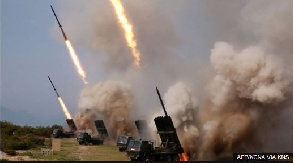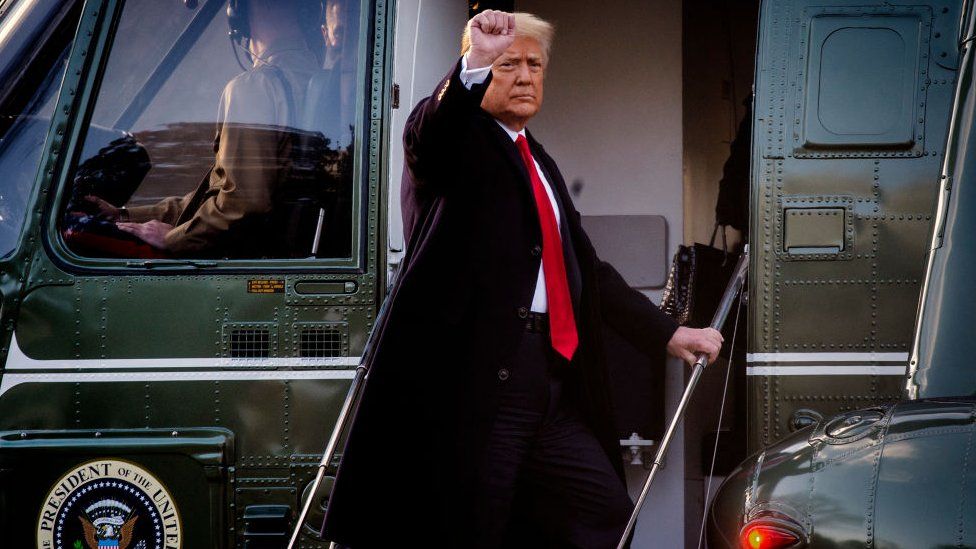North Korea: Kim Jong-un oversees ‘strike drill’ missile component test

North Korea has confirmed via state media that leader Kim Jong-un has overseen a “strike drill” testing various missile components.
“A number of short-range projectiles” were also fired from the Hodo peninsula into the Sea of Japan on Saturday.
North Korea’s leader gave the order of firing to “increase the combat ability” of the country, the announcement said.
US President Donald Trump tweeted he believed Mr Kim would not jeopardise the path towards better relations.
He added that the North Korean leader “knows that I am with him & does not want to break his promise to me. Deal will happen!
“I believe that Kim Jong-Un fully realises the great economic potential of North Korea and will do nothing to interfere or end it,” Mr Trump posted on social media on Saturday.
President Trump walked away from what he described as a bad deal offered by Kim Jong-un at a summit meeting in Hanoi in February.
In its report on Sunday, the Korean Central News Agency (KCNA) said Mr Kim had stressed the need to “defend the political sovereignty and economic self-sustenance” of the country in the face of threat and invasion.
The aim of the drill, which was testing “large-calibre long-range multiple rocket launchers”, was to “inspect the operating ability and the accuracy of striking duty performance,” the report said.
The North Korean president told troops to bear in mind “the iron truth that genuine peace and security are ensured and guaranteed only by powerful strength”.
What’s the background?
It is believed that Saturday’s test is intended to increase pressure on Washington to move nuclear talks forward.
Last month, North Korea said it had tested what it described as a new “tactical guided weapon”.
That was the first test since the Hanoi summit.
Analysts say a short-range solid fuel ballistic missile was fired on Saturday, making this the most serious test since North Korea fired an intercontinental ballistic missile in November 2017.
However, it does not violate North Korea’s promise not to test long-range or nuclear missiles.
But Pyongyang appears to be growing impatient with Washington’s insistence that full economic sanctions remain until Mr Kim takes serious steps to dismantle his nuclear weapons programme, says the BBC’s Laura Bicker.
What’s the reaction been?
South Korea’s Joint Chiefs of Staff said in a statement that North Korea “fired a number of short-range missiles from its Hodo peninsula near the east coast town of Wonsan to the north-eastern direction from 09:06 (00:06 GMT) to 09:27” on Saturday.
The missiles flew for between 70km and 200km (45-125 miles) before landing in the Sea of Japan, they added.
Seoul has previously called on Pyongyang to “stop acts that escalate military tension on the Korean peninsula”.
“North Korea’s recent missile launches are a provocation at a time when the international community is awaiting concrete steps from North Korea to abandon its nuclear weapons and missile programme,” the German Foreign Ministry said, according to AFP.
“We welcome President Trump’s declaration that he is ready to continue to support the negotiations process despite this provocation,” the statement said.
Weapon testing in North Korea
Hodo has been used in the past for launching cruise missiles and long-range artillery testing.
According to KCNA, April’s test of a new “tactical guided weapon” was also overseen by Mr Kim himself. It was “conducted in various modes of firing at different targets”, which analysts believe means the weapon could be launched from land, sea or air.
It is unclear if that weapon was a missile, but most observers agree that it was probably a short-range weapon.
Last year, Mr Kim said he would stop nuclear testing and would no longer launch intercontinental ballistic missiles.
Nuclear activity appears to be continuing, however, and satellite images of North Korea’s main nuclear site last month showed movement, suggesting the country could be reprocessing radioactive material into bomb fuel.
The country claims it has developed a nuclear bomb small enough to fit on a long-range missile, as well as ballistic missiles that could potentially reach the mainland US.
Source: bbc.com





